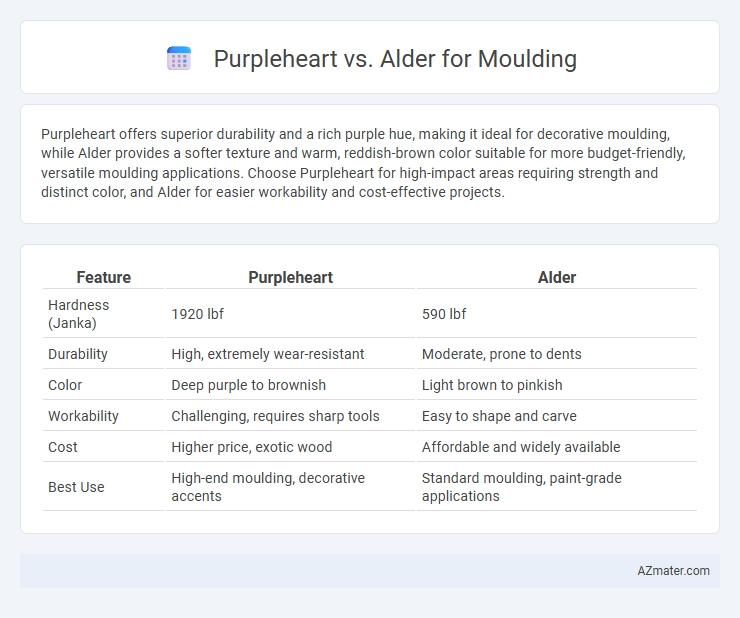Purpleheart offers superior durability and a rich purple hue, making it ideal for decorative moulding, while Alder provides a softer texture and warm, reddish-brown color suitable for more budget-friendly, versatile moulding applications. Choose Purpleheart for high-impact areas requiring strength and distinct color, and Alder for easier workability and cost-effective projects.
Table of Comparison
| Feature | Purpleheart | Alder |
|---|---|---|
| Hardness (Janka) | 1920 lbf | 590 lbf |
| Durability | High, extremely wear-resistant | Moderate, prone to dents |
| Color | Deep purple to brownish | Light brown to pinkish |
| Workability | Challenging, requires sharp tools | Easy to shape and carve |
| Cost | Higher price, exotic wood | Affordable and widely available |
| Best Use | High-end moulding, decorative accents | Standard moulding, paint-grade applications |
Introduction to Purpleheart and Alder Woods
Purpleheart wood, known for its distinctive deep purple color and exceptional durability, is highly sought after for moulding applications requiring both aesthetic appeal and strength. Alder wood offers a softer, light-toned alternative with fine grain and excellent machinability, making it ideal for intricate moulding details and interior finishes. Both woods vary significantly in hardness and appearance, influencing their suitability based on project requirements and design preferences.
Botanical Origins and Availability
Purpleheart, derived from the Peltogyne genus native to Central and South America, showcases a rich purple hue and dense grain, making it highly prized yet less commonly available. Alder, sourced from Alnus species predominantly found in North America, offers a softer, lighter-toned wood with a more consistent supply due to widespread growth. Availability of Purpleheart is often limited and sometimes regulated due to sustainable harvesting concerns, whereas Alder benefits from greater commercial accessibility and cost-effectiveness in moulding applications.
Color and Visual Appeal Comparison
Purpleheart displays a rich, vibrant purple hue that deepens over time, creating a unique and eye-catching moulding option. Alder offers a more subtle, uniform light brown to reddish tone with a smooth, consistent grain pattern ideal for classic or understated designs. The striking, dynamic coloration of Purpleheart makes it a standout choice for bold, decorative mouldings, while Alder's warm and neutral shades provide versatile appeal for a variety of interior styles.
Durability and Hardness in Moulding Applications
Purpleheart offers superior durability and hardness compared to Alder, making it highly suited for moulding applications requiring long-lasting wear resistance. With a Janka hardness rating of about 2,520 lbf, Purpleheart withstands dents and scratches better than Alder, which has a much lower Janka hardness around 590 lbf. This enhanced hardness ensures Purpleheart mouldings maintain their structural integrity and aesthetic appeal under frequent impact or pressure, outperforming Alder in demanding environments.
Workability and Ease of Shaping
Purpleheart wood is significantly harder and denser than Alder, making it more challenging to shape and requiring sharper tools for precise moulding work. Alder offers superior workability due to its softer texture and consistent grain, allowing for smoother cuts, easier sanding, and quicker finishing processes. The choice between these woods for moulding depends on the balance between the desired durability of Purpleheart and the ease and speed of working with Alder.
Resistance to Moisture and Decay
Purpleheart wood demonstrates superior resistance to moisture and decay compared to Alder, making it more suitable for moulding in humid or wet environments. Its dense, oily composition provides natural durability against fungal attacks and swelling, extending the lifespan of mouldings. Alder, while easier to work with and cost-effective, is more prone to moisture absorption and decay, requiring additional treatment for use in moisture-prone areas.
Cost Comparison: Purpleheart vs Alder
Purpleheart wood is significantly more expensive than alder due to its rarity and vibrant color, with prices often ranging from $15 to $25 per board foot compared to alder's $3 to $6 per board foot. The higher cost of Purpleheart makes it less commonly used for moulding in budget-sensitive projects, while alder offers an affordable and widely available option. Despite the price difference, Purpleheart provides exceptional durability and a unique purple hue, justifying its premium cost for high-end moulding applications.
Environmental Sustainability Factors
Purpleheart wood, known for its dense hardness and natural resistance to decay, offers long-term durability which reduces the need for frequent replacements, enhancing environmental sustainability by minimizing resource consumption. Alder, a fast-growing hardwood, supports sustainability through its quicker replenishment rate and lower environmental impact during harvesting, making it a more renewable option for moulding projects. Both woods have eco-friendly attributes, but choosing between the two depends on balancing longevity (Purpleheart) versus rapid renewability and lower carbon footprint (Alder).
Popular Uses in Moulding and Interior Design
Purpleheart is prized in moulding for its vibrant purple hue and exceptional durability, often used in accent pieces and decorative trims that highlight luxury interiors. Alder is favored for its fine, straight grain and smooth finish, making it ideal for intricate moulding work and painted interior details. Both woods offer unique aesthetic and functional benefits, with Purpleheart enhancing visual impact and Alder providing versatility in design applications.
Choosing the Right Wood: Purpleheart or Alder
Purpleheart offers exceptional durability and a rich, deep purple hue that darkens over time, making it ideal for high-end moulding projects requiring strength and longevity. Alder, known for its smooth texture and light, warm tones, is easier to work with and stains well, suitable for moulding where cost-effectiveness and versatility are priorities. Selecting between Purpleheart and Alder depends on desired aesthetics, durability requirements, and project budget for moulding applications.

Infographic: Purpleheart vs Alder for Moulding
 azmater.com
azmater.com